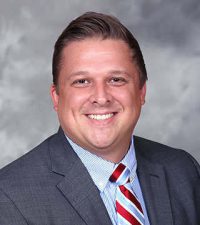
Harper Morton was at first thought to be too small for spinal fusion surgery, but it was key to her continued growth and development.
By Maureen Gilmer, Riley Children’s Health senior writer, mgilmer1@iuhealth.org
When Harper Morton smiles, it’s reflected right back at her, because how can you not grin at all the cuteness?
With her stand-up pigtails, twinkling blue eyes and five little teeth, she can turn a gray day on its head.
The 1-year-old from Boonville, Indiana, has become a regular at Riley Hospital for Children in her young life. She has doctors, nurses and therapists wrapped around her tiny fingers.

But aside from her precious personality, her medical journey has been a marvel of sorts for an interdisciplinary team at Riley.
Harper, the daughter of Cory and Jennifer Morton, was diagnosed with kyphosis of the spine, an excessive forward curve in the upper back, resulting in a rounded posture. This was caused by a thoracic vertebral malformation, resulting in severe compression of her spinal cord, which led to urinary and kidney problems.
On top of that, doctors were concerned that the severe stenosis of her spinal cord could lead to neurological injury in her legs.

Surgery seemed the logical answer, but it was quite rare on a patient so young. Combining their years of expertise, several Riley providers collaborated on the case, including: Drs. Tyler Christman and Aki Puryear, orthopedics; Dr. Rabia Qaiser, neurosurgery; Dr. Robert Presson Jr., anesthesiology; and Dr. Katelyn Makar, plastic surgeon.
In preparation for this surgery, Riley doctors consulted with several other pediatric spine surgeons across the country.
Harper was just 9 months old when she had the delicate spinal fusion surgery in February. Both Drs. Christman and Puryear said the baby’s size was challenging.
The doctors had a model made of her spine and used it for surgical planning. The goal was to decompress the area, adding space and stabilizing the spine.

Dr. Qaiser acknowledged the tricky nature of the repair, noting that there is risk of paralysis. And while there was a point during surgery when they lost motor signals, “when she woke up, she was back to baseline. She never missed a beat. It was awesome.”
“The neuro-monitoring team was critical during surgery as they were monitoring all the motor and sensory functions,” she said, “and the anesthesia team was extremely critical as well because they were making sure the anesthesia was given and that her pressures were enough to continue to profuse the spinal cord at an optimal level.”
Stabilizing the segment of spine required screws and a short segment of rod, but it was difficult to find implants that would accommodate a baby.
“We made some modifications with some adult implants that would fit her,” Dr. Christman said.
“Originally, doctors didn’t want to operate until she was 5 or 6, if it wasn’t affecting anything,” Jennifer Morton said, “but her urine was backing up and the kyphosis was pushing on her spine, so they decided to do it earlier.”

As the ortho and neurosurgery team completed their work, Dr. Makar joined the OR team to cover the implanted hardware.
“I was involved to provide robust soft tissue coverage over the hardware, using nearby muscle that is expendable,” she said. “Doing this type of closure decreases the risk of infection and hardware exposure.”
A brace was placed over Harper’s torso and abdomen to help protect the construct while she heals, but she is doing well today.
The Mortons are breathing easier, now that surgery is behind them.
“It was really scary,” Jennifer acknowledged. “They were worried about her becoming paralyzed. It’s a weight on your chest. It’s like I didn’t release a breath until they came out and said she was in recovery.”

Since Harper has been home, she is back to her cute self, her mom said, learning to clap and trying to stand. She was back at Riley today to have another cast removed after clubfoot surgery with Dr. Christine Caltoum.
“She’s a happy baby, but she’ll let you know when she’s angry,” Jennifer said during a visit to the Riley Outpatient Center for follow-up care. “She’s very resilient. You wouldn’t think she’s gone through everything she has in her little life.”
“I think that Harper’s outlook at this point is good,” Dr. Christman said. “Things look very stable on her X-rays. Of course, she will need further monitoring and future X-rays to determine the stability of the screws and rods, and she may need additional surgical procedures in the future.”

Whatever comes next, the Mortons say they appreciate the entire Riley team that has supported them throughout the past several months.
“We’re very grateful for Riley. They are lifesavers,” Jennifer said. “It’s almost like family now because we’ve been here so often. They make sure you know they are here for your kid. I wouldn’t go anywhere else now that we’ve been here.”
Harper and her family will be back in Indianapolis next month for an Indianapolis Indians game. She has been selected as a First Pitch Kid, so she will throw out the first pitch (with some help) at the July 12 game.
Her parents are excited to bring her and her three siblings to their first game at Victory Field, but fair warning, they say: “She’ll probably try to eat the ball.”
Photos submitted and by Mike Dickbernd, IU Health visual journalist, mdickbernd@iuhealth.org







